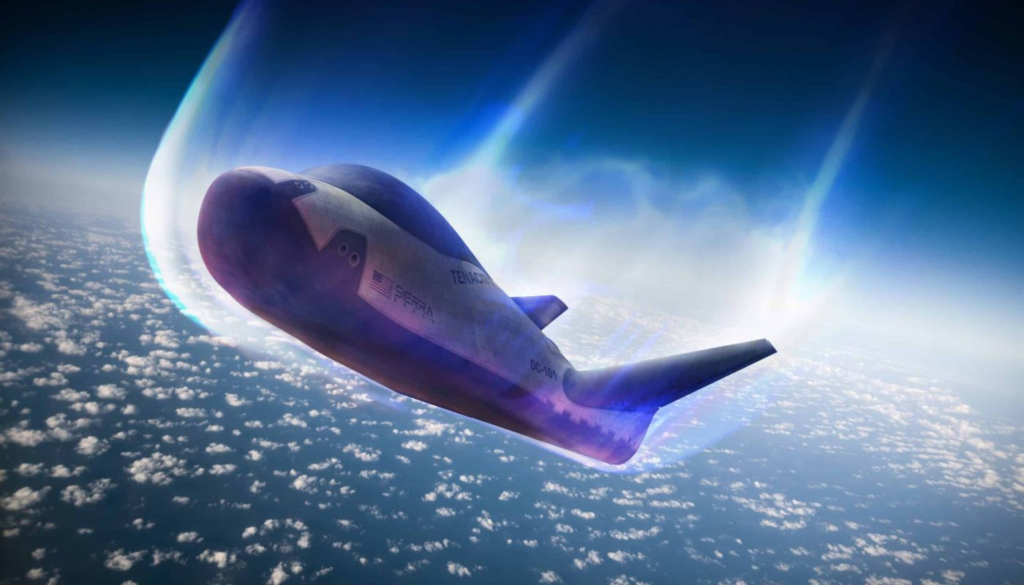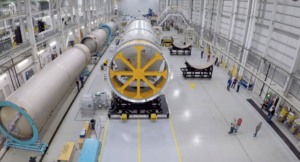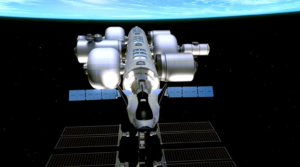
Dream Chaser Tenacity Is Vertical & Stacked On Shooting Star!
The last time a spaceplane docked at the International Space Station was over a decade ago in 2011. Soon after the Space Shuttle was retired and frequent missions came to a stop. Now in 2024, we are only months away from the return of spaceplanes within the industry. Just yesterday it was announced that Dream Chaser Tenacity and its Shooting Star cargo module are stacked and vertical.
This is the first time the two have come together and so far the signs are looking good for maiden flight. In this mission, they will launch on ULA’s Vulcan rocket and attempt to dock to the International Space Station, before returning to Earth for a runway landing. Here I will go more in-depth into the recent milestone, final launch prep, the significance of this mission, and more.
Tenacity Is Vertical

Yesterday Sierra Space tweeted saying, “Today, the Sierra Space team has arrived at a profound milestone in our amazing journey – one of audacious dreaming and tenacious doing. We are now living in the Orbital Age.” This included an image of Tenacity and Shooting Star stacked and in launch configuration for the first time. You can see the spaceplane’s wings are folded in which allows it to fit within the rocket’s fairings. Similarly, Shooting Star has large solar panels that are also folded in for launch and will extend on orbit. For the last month and a half, the spaceplane has been at NASA’s Glenn Research Center to complete pre-launch testing. At this point, the vehicle is complete and they are making sure it can survive both the launch and space environment.
The reason Tenacity is stacked and vertical is for vibration testing. Here they simulate the vibrations the vehicle will be exposed to as Vulcan lifts off. This is why it’s in launch configuration as they need to make this process as accurate as possible. The only difference between some of the images they provided and the actual launch is there will be fairings covering the vehicle. Inside the NASA Glenn Research Center is the world’s most powerful spacecraft shaker system. In a quote, the agency said, “We exposed Dream Chaser and Shooting Star to the vibrations they’ll experience during launch and reentry to the Earth’s atmosphere.”
With the vehicle now vertical, we can expect this testing to take place and likely be completed within the next week or so. Once done, assuming the results are promising, there are a few more tests that need to be completed. In a statement they said, “Following vibration testing, Dream Chaser will be moved to the propulsion facility for thermal vacuum testing. Dream Chaser will be placed in a vacuum and exposed to low ambient pressures, low-background temperatures, and replicated dynamic solar heating, which simulates the environment the spacecraft will encounter during its mission. This facility is the only one capable of testing full-scale, upper stage rockets and rocket engines under simulated space conditions and conducting altitude hot fire.” They finished by saying, “After completion of testing at Armstrong, Dream Chaser will be shipped to NASA’s Kennedy Space Center in Florida for further launch preparations, currently scheduled for liftoff in the first half of 2024.”
In other words, we can expect Tenacity to complete all of this testing within the next month or so. It will then head to Florida where it will integrate on top of the Vulcan launch vehicle. While we haven’t heard much from ULA since the first successful flight, a few comments suggest they are nearly ready. For example in a statement early last month they said, “The second certification mission (Cert-2) is planned to launch in the coming months.” In addition, the vice president of United Launch Alliance said that the earliest opportunity to launch Tenacity would be around April. This suggests that April or May accounting for a few delays is a realistic launch timeframe for this vehicle.
In reality, Dream Chaser has been under development for decades. Over this long period of time they have worked on the design, initial testing, general work, etc. This makes the maiden flight an even bigger deal with the amount of time that’s gone into it. Since this is a reusable vehicle, the plan is for it to survive its mission and allow teams as Sierra Space to refurbish it and prepare it for another mission. However, if things go wrong and the vehicle is lost, the company has another test article they’ve been working on for a while now. Even though it’s not complete, there are other options and backups.
The Return of Spaceplanes

Even though vehicles like Boeing’s X-37B have been launching somewhat consistently for years now, it has been a long time since a spaceplane designed for commercial operations has flown. Tenacity, this first test article is an uncrewed spaceplane meant to transport cargo to and from low Earth orbit destinations. Its upcoming mission is the first in a bigger contract with NASA. Specifically, in 2016, NASA announced that Dream Chaser had been awarded one of the CRS-2 contracts and committed to purchasing a minimum of six resupply missions to the ISS.
Tenacity is 30 feet (9 meters) long, which is roughly a quarter of the total length of the space shuttle orbiters. The cargo module is a flexible 15-foot transport and cargo vehicle to be used as an attachment to the Dream Chaser spaceplane. Together, the two can deliver up to 12,000 pounds (5400 kg) of pressurized and unpressurized cargo to low-Earth orbit.
With this vehicle being uncrewed, it can launch within a rocket’s fairings as there is no need for an abort capability, which also provides some benefits. Not only does this make it compatible with any launch vehicle featuring a 5m or larger fairing, but it also makes it more flexible by reducing ascent loads on the vehicle and protecting it from debris.
Despite this upcoming mission being the first fight of Dream Chaser, they plan to send around 3,500 kg of cargo to the station. Once it arrives it will stay docked to the ISS for around 45 days before attempting reentry. Utilizing internally developed thrusters with three different thrust modes, Tenacity can maneuver in space and ensure deliveries are effectively completed. Thanks to the vehicle’s design, Dream Chaser can safely return critical cargo including supplies and science experiments to Earth at less than 1.5g’s on compatible commercial runways, making cargo accessible faster.
For years now Sierra Space has been trying to create partnerships and contracts with runways around the world. The goal is to allow Dream Chaser to land at a long list of sites. Back in 2022 for example, Sierra Space and Spaceport America announced the signing of a Memorandum of Understanding (MOU). The agreement added the New Mexico spaceport to Sierra Space’s portfolio of potential global landing sites for Dream Chaser. In a statement they said, “Spaceport America, located in southern New Mexico, is the most recent addition to a growing list of compatible runways worldwide where the Dream Chaser could land, including the Shuttle Landing Facility (SLF) at NASA’s Kennedy Space Center and airports and landing sites in Huntsville, Alabama, Oita Airport, Japan, and Spaceport Cornwall in the United Kingdom.” In the future, we can expect to begin seeing these different landing options utilized.
As far as readiness for Dream Chaser missions to the ISS, multiple NASA astronaut crews have visited Sierra Space facilities to undergo detailed training on understanding the vehicle, rendezvous and proximity operations, hardware, and cargo transfer scenarios in anticipation of Dream Chaser deliveries to the ISS. This training is conducted by Sierra Space subject matter experts and includes classroom training and training inside a full-size mock-up of Dream Chaser. This will help crews when Tenacity actually berths to the station.
Up until now, Tenacity has had some tests but nothing like what it’s about to experience. In 2017, Sierra Space conducted a test flight where the team tested the Dream Chaser hardware during an autonomously conducted atmospheric test flight. On descent over the California desert, the Dream Chaser test vehicle autonomously deployed its landing gear, touching down on the runway at NASA’s Armstrong Flight Research Center in Edwards, California, demonstrating the spaceplane’s unique lifting body design. This was actually the second attempt as the first time one of the landing legs didn’t deploy causing the test article to crash. This has all since been addressed and now they are just about ready.
The Sierra Space CEO Tom Vice said in a quote, “At Sierra Space, we are ushering in the next industrial revolution with a business and technology platform that provides our customers with a complete turn-key solution offering space as a service. Our platform includes Dream Chaser, a revolutionary, highly reusable commercial spaceplane with global runway access, and the first business-ready commercial space station, leveraging the most advanced expandable structural architecture that will exponentially decrease the cost of product development and manufacturing in space” he said. Its clear the company is confident in its product and the future of this system. What’s even more exciting is that Sierra Space has plans for different Dream Chaser variants including a crewed option. All of which will build off of this upcoming test flight.
Conclusion
Dream Chaser Tenacity for the first time is vertical and in launch configuration. This is for the final testing both of vibrations and eventually propulsion. We will have to wait and see how it progresses and the impact it has on the space industry.



